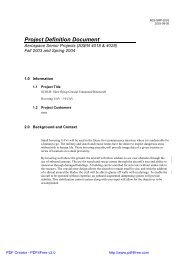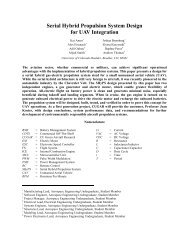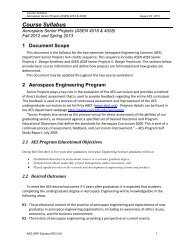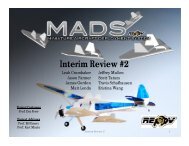PFR - Aerospace Engineering Sciences Senior Design Projects ...
PFR - Aerospace Engineering Sciences Senior Design Projects ...
PFR - Aerospace Engineering Sciences Senior Design Projects ...
You also want an ePaper? Increase the reach of your titles
YUMPU automatically turns print PDFs into web optimized ePapers that Google loves.
Project Final Report – CUDBF April 30 th , 2009<br />
ASEN 4028: <strong>Aerospace</strong> <strong>Senior</strong> <strong>Projects</strong><br />
transmitter was set so the microcontroller was disarmed. A power source was used for the<br />
transmitter, so the transmitter would not lose power during testing and provide false results. The<br />
setup of this experiment is shown in Figure 121.<br />
Figure 121: PIC testing<br />
The PIC was programmed such that if it got past the arming routine and starts to read the control<br />
surface signals, an LED would turn on. After 90 minutes of testing, no false signals were read<br />
by the microcontroller. To ensure communication between the transmitter and the PIC was still<br />
working, the arming/disarming switch was flipped at the end of the test. When the switch was<br />
moved to the “arm” position at the end of the test, the LED turned on, confirming no<br />
communication loss, indicating that the PIC was programmed correctly for the test. With the<br />
results of these two tests, it was determined that the microcontroller was indeed safe to use for<br />
competition.<br />
13.2 System Verification and Validation<br />
13.2.1Wingtip Lift Test<br />
Before any flight testing can be completed, had to be lifted off the ground by the wingtips. This<br />
test simulates a 2.5g load at the root of the wing, and is demonstrated to the judges upon<br />
technical inspection at competition. This test demonstrates that the aircraft’s structure is flight<br />
worthy. Each model of the Buff-2 successfully passed the wingtip lift test.<br />
13.2.2 System Flight Testing<br />
13.2.2.1 Flight Test #1<br />
The purpose of flight test #1 was to assess the general aerodynamic flying qualities and test the<br />
proof-of-concept of the flying wing design with the aerodynamic prototype, Buff-2A. As a safety<br />
precaution for the first flight, the aircraft was initially ballasted with weight in order to increase<br />
the static margin to 10% to ensure the aircraft was stable. The goal was to have the pilot takeoff,<br />
fly for no more than two minutes, and land the aircraft. The purpose of this flight test was purely<br />
to get qualitative data on aircraft handling characteristics from the pilot.<br />
138
















